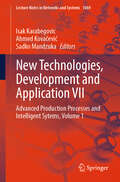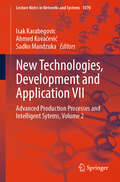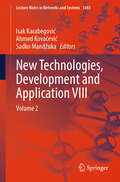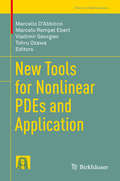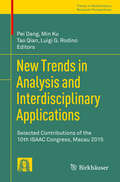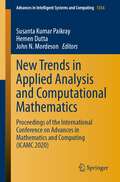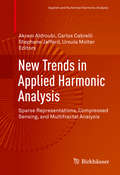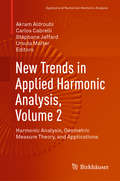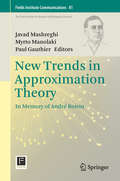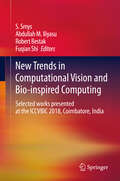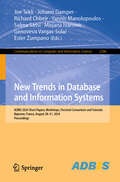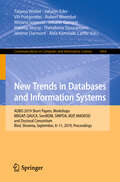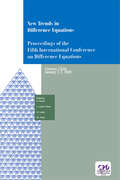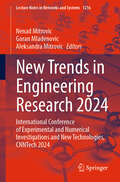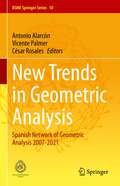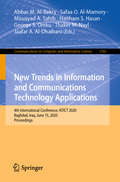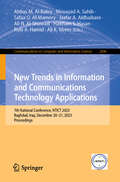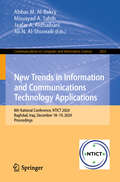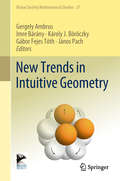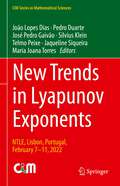- Table View
- List View
New Technologies, Development and Application VII: Advanced Production Processes and Intelligent Sytems, Volume 1 (Lecture Notes in Networks and Systems #1069)
by Ahmed Kovačević Isak Karabegovic Sadko MandzukaThis book features papers focusing on the implementation of new and future technologies, which were presented at the International Conference on New Technologies, Development and Application—Advanced Production Processes and Intelligent Systems held at the Academy of Science and Arts of Bosnia and Herzegovina in Sarajevo on 20–22 June 2024. It covers a wide range of future technologies and technical disciplines, including complex systems such as Industry 4.0; robotics; mechatronics systems; automation; manufacturing; cyber-physical and autonomous systems; sensors; networks; control, energy, renewable energy sources; automotive and biological systems; vehicular networking and connected vehicles; and intelligent transport, effectiveness and logistics systems, smart grids, nonlinear systems, power, social and economic systems, education, and IoT. The book New Technologies, Development and Application VII is oriented toward Fourth Industrial Revolution “Industry 4.0”, which implementation will improve many aspects of human life in all segments and lead to changes in business paradigms and production models. Further, new business methods are emerging, transforming production systems, transport, delivery, and consumption, which need to be monitored and implemented by every company involved in the global market.
New Technologies, Development and Application VII: Advanced Production Processes and Intelligent Sytems, Volume 2 (Lecture Notes in Networks and Systems #1070)
by Ahmed Kovačević Isak Karabegovic Sadko MandzukaThis book features papers focusing on the implementation of new and future technologies, which were presented at the International Conference on New Technologies, Development and Application—Advanced Production Processes and Intelligent Systems held at the Academy of Science and Arts of Bosnia and Herzegovina in Sarajevo on 20–22 June 2024. It covers a wide range of future technologies and technical disciplines, including complex systems such as Industry 4.0; robotics; mechatronics systems; automation; manufacturing; cyber-physical and autonomous systems; sensors; networks; control, energy, renewable energy sources; automotive and biological systems; vehicular networking and connected vehicles; and intelligent transport, effectiveness and logistics systems, smart grids, nonlinear systems, power, social and economic systems, education, and IoT. The book New Technologies, Development and Application VII is oriented toward Fourth Industrial Revolution “Industry 4.0”, which implementation will improve many aspects of human life in all segments and lead to changes in business paradigms and production models. Further, new business methods are emerging, transforming production systems, transport, delivery, and consumption, which need to be monitored and implemented by every company involved in the global market.
New Technologies, Development and Application VIII: Volume 1 (Lecture Notes in Networks and Systems #1482)
by Isak Karabegović Ahmed Kovačević Sadko MandžukaThis book provides a comprehensive overview of the latest technological achievements, their development and practical applications in various industries. In a world that is constantly changing, technology is the driving force behind progress. This book contains papers focusing on the implementation of new and future technologies, which were presented at the International Conference on New Technologies, Development and Application—Advanced Manufacturing Processes and Intelligent Systems, held at the Academy of Sciences and Arts of Bosnia and Herzegovina in Sarajevo from 26 to 28 June 2025. Through clear and concise analyses, the authors explore key innovations such as robotics, artificial intelligence, internet of things, blockchain, biotechnology and sustainable solutions. Furthermore, new business methods are emerging that are transforming production systems, transportation, delivery and consumption, which every company involved in the global market should monitor and implement. The book offers in-depth insight into how these technologies are transforming business, education, health care and everyday life. Whether you're a professional looking to stay up to date with the latest trends, a student exploring future career opportunities, or an enthusiast interested in technological change, this book provides useful information and practical, real-world examples. Don't let the future surprise you—find out how new technologies are shaping the world and how you can apply them today.
New Technologies, Development and Application VIII: Volume 2 (Lecture Notes in Networks and Systems #1483)
by Isak Karabegović Ahmed Kovačević Sadko MandžukaThis book provides a comprehensive overview of the latest technological achievements, their development and practical applications in various industries. In a world that is constantly changing, technology is the driving force behind progress. This book contains papers focusing on the implementation of new and future technologies, which were presented at the International Conference on New Technologies, Development and Application—Advanced Manufacturing Processes and Intelligent Systems, held at the Academy of Sciences and Arts of Bosnia and Herzegovina in Sarajevo from 26 to 28 June 2025. Through clear and concise analyses, the authors explore key innovations such as robotics, artificial intelligence, internet of things, blockchain, biotechnology and sustainable solutions. Furthermore, new business methods are emerging that are transforming production systems, transportation, delivery and consumption, which every company involved in the global market should monitor and implement. The book offers in-depth insight into how these technologies are transforming business, education, health care and everyday life. Whether you're a professional looking to stay up to date with the latest trends, a student exploring future career opportunities, or an enthusiast interested in technological change, this book provides useful information and practical, real-world examples. Don't let the future surprise you—find out how new technologies are shaping the world and how you can apply them today.
New Tools for Nonlinear PDEs and Application (Trends in Mathematics)
by Marcello D'Abbicco Marcelo Rempel Ebert Vladimir Georgiev Tohru OzawaThis book features a collection of papers devoted to recent results in nonlinear partial differential equations and applications. It presents an excellent source of information on the state-of-the-art, new methods, and trends in this topic and related areas. Most of the contributors presented their work during the sessions "Recent progress in evolution equations" and "Nonlinear PDEs" at the 12th ISAAC congress held in 2017 in Växjö, Sweden. Even if inspired by this event, this book is not merely a collection of proceedings, but a stand-alone project gathering original contributions from active researchers on the latest trends in nonlinear evolution PDEs.
New Tools in Mathematical Analysis and Applications: Proceedings of the 14th ISAAC Congress 2023, Ribeirão Preto, Brazil (Trends in Mathematics)
by Irene Sabadini Marcelo R. Ebert Joachim Toft Uwe KählerThis volume contains the contributions of the participants of the 14th ISAAC congress, held at the University of São Paulo, Campus Ribeirão Preto, Brazil, on July 17-21, 2023. The papers, written by respected international experts, address recent results in mathematics, with a special focus on analysis. The volume constitutes a valuable resource on current research in mathematical analysis and its various interdisciplinary applications, both for specialists and non-specialists alike.
New Trends in Analysis and Interdisciplinary Applications
by Tao Qian Luigi G. Rodino Pei Dang Min KuThe book provides a collection of papers from the 10th ISAAC Congress 2015 in Macau, China. The papers, given by international experts are devoted to recent results in Mathematics, focusing especially on Analysis. By structuring the content according to the various mathematical topics, the volume offers specialists and non-specialists an excellent information on the state-of-the-art in Mathematical Analysis and its interdisciplinary applications.
New Trends in Analysis and Interdisciplinary Applications: Selected Contributions of the 10th ISAAC Congress, Macau 2015 (Trends in Mathematics)
by Tao Qian Luigi G. Rodino Pei Dang Min KuThis book presents a collection of papers from the 10th ISAAC Congress 2015, held in Macau, China. The papers, prepared by respected international experts, address recent results in Mathematics, with a special focus on Analysis. By structuring the content according to the various mathematical topics, the volume offers specialists and non-specialists alike an excellent source of information on the state-of-the-art in Mathematical Analysis and its interdisciplinary applications.
New Trends in Applied Analysis and Computational Mathematics
by John N. Mordeson Hemen Dutta Susanta Kumar PaikrayThe volume contains original research papers as the Proceedings of the International Conference on Advances in Mathematics and Computing, held at Veer Surendra Sai University of Technology, Odisha, India, on 7-8 February, 2020. It focuses on new trends in applied analysis, computational mathematics and related areas. It also includes certain new models, image analysis technique, fluid flow problems, etc. as applications of mathematical analysis and computational mathematics. <P><P> The volume should bring forward new and emerging topics of mathematics and computing having potential applications and uses in other areas of sciences. It can serve as a valuable resource for graduate students, researchers and educators interested in mathematical tools and techniques for solving various problems arising in science and engineering.
New Trends in Applied Harmonic Analysis
by Akram Aldroubi Carlos Cabrelli Stephane Jaffard Ursula MolterThis volume is a selection of written notes corresponding to courses taught at the CIMPA School: "New Trends in Applied Harmonic Analysis:Sparse Representations, Compressed Sensing and Multifractal Analysis". Newinteractions between harmonic analysis and signal and image processing haveseen striking development in the last 10 years, and several technologicaldeadlocks have been solved through the resolution of deep theoretical problemsin harmonic analysis. New Trends in Applied Harmonic Analysis focuses on twoparticularly active areas that are representative of such advances:multifractal analysis, and sparse representation and compressed sensing. Thecontributions are written by leaders in these areas, and cover boththeoretical aspects and applications. This work should prove useful not only toPhD students and postdocs in mathematics and signal and image processing,but also to researchers working in related topics.
New Trends in Applied Harmonic Analysis, Volume 2: Harmonic Analysis, Geometric Measure Theory, and Applications (Applied and Numerical Harmonic Analysis)
by Akram Aldroubi Carlos Cabrelli Ursula Molter Stéphane JaffardThis contributed volume collects papers based on courses and talks given at the 2017 CIMPA school Harmonic Analysis, Geometric Measure Theory and Applications, which took place at the University of Buenos Aires in August 2017. These articles highlight recent breakthroughs in both harmonic analysis and geometric measure theory, particularly focusing on their impact on image and signal processing. The wide range of expertise present in these articles will help readers contextualize how these breakthroughs have been instrumental in resolving deep theoretical problems. Some topics covered include:Gabor framesFalconer distance problemHausdorff dimensionSparse inequalitiesFractional Brownian motionFourier analysis in geometric measure theoryThis volume is ideal for applied and pure mathematicians interested in the areas of image and signal processing. Electrical engineers and statisticians studying these fields will also find this to be a valuable resource.
New Trends in Approximation Theory: In Memory Of André Boivin (Fields Institute Communications Ser. #81)
by Javad Mashreghi Myrto Manolaki Paul GauthierThe international conference entitled "New Trends in Approximation Theory" was held at the Fields Institute, in Toronto, from July 25 until July 29, 2016. The conference was fondly dedicated to the memory of our unique friend and colleague, André Boivin, who gave tireless service in Canada until his very last moment of his life in October 2014. The impact of his warm personality and his fine work on Complex Approximation Theory was reflected by the mathematical excellence and the wide research range of the 37 participants. In total there were 27 talks, delivered by well-established mathematicians and young researchers. In particular, 19 invited lectures were delivered by leading experts of the field, from 8 different countries. The wide variety of presentations composed a mosaic of aspects of approximation theory, highlighting interesting connections with important contemporary areas of Analysis. Primary topics discussed include application of approximation theory (isoperimetric inequalities, construction of entire order-isomorphisms, dynamical sampling); approximation by harmonic and holomorphic functions (especially uniform and tangential approximation), polynomial and rational approximation; zeros of approximants and zero-free approximation; tools used in approximation theory; approximation on complex manifolds, in product domains, and in function spaces; and boundary behaviour and universality properties of Taylor and Dirichlet series.
New Trends in Computational Vision and Bio-inspired Computing: Selected works presented at the ICCVBIC 2018, Coimbatore, India
by S. Smys Robert Bestak Fuqian Shi Abdullah M. IliyasuThis volume gathers selected, peer-reviewed original contributions presented at the International Conference on Computational Vision and Bio-inspired Computing (ICCVBIC) conference which was held in Coimbatore, India, on November 29-30, 2018. The works included here offer a rich and diverse sampling of recent developments in the fields of Computational Vision, Fuzzy, Image Processing and Bio-inspired Computing. The topics covered include computer vision; cryptography and digital privacy; machine learning and artificial neural networks; genetic algorithms and computational intelligence; the Internet of Things; and biometric systems, to name but a few. The applications discussed range from security, healthcare and epidemic control to urban computing, agriculture and robotics.In this book, researchers, graduate students and professionals will find innovative solutions to real-world problems in industry and society as a whole, together with inspirations for further research.
New Trends in Database and Information Systems: ADBIS 2024 Short Papers, Workshops, Doctoral Consortium and Tutorials, Bayonne, France, August 28–31, 2024, Proceedings (Communications in Computer and Information Science #2186)
by Richard Chbeir Yannis Manolopoulos Johann Gamper Mirjana Ivanovic Genoveva Vargas-Solar Ester Zumpano Joe Tekli Salma SassiThis book constitutes short papers, Doctoral Consortium and Workshops papers which were held in conjunction with the 28th European Conference on New Trends in Databases and Information Systems, ADBIS 2024, which took place in Bayonne, France, during August 28–31, 2024. The total of 28 full papers and 7 short papers presented in this book were carefully reviewed and selected from 103 submissions. They were organized in the following topical sections: Doctoral Consortium; 5th Workshop on Intelligent Data - From Data to Knowledge (DOING 2024); 3rd Workshop on Knowledge Graphs Analysis on a Large Scale (K-GALS 2024); 6th Workshop on Modern Approaches in Data Engineering and Information System Design (MADEISD 2024); 3rd Workshop on Personalization and Recommender Systems (PERS 2024); Access methods and query processing; discovery and data analysis; Machine Learning; large language models; and tutorials.
New Trends in Databases and Information Systems: ADBIS 2019 Short Papers, Workshops BBIGAP, QAUCA, SemBDM, SIMPDA, M2P, MADEISD, and Doctoral Consortium, Bled, Slovenia, September 8–11, 2019, Proceedings (Communications in Computer and Information Science #1064)
by Mirjana Ivanović Tatjana Welzer Johann Eder Johann Gamper Robert Wrembel Jérôme Darmont Vili Podgorelec Mikoƚaj Morzy Theodoros Tzouramanis Aida Kamišalić LatifićThis book constitutes the thoroughly refereed short papers, workshops and doctoral consortium papers of the 23rd European Conference on Advances in Databases and Information Systems, ADBIS 2019, held in Bled, Slovenia, in September 2019.The 19 short research papers and the 5 doctoral consortium papers were carefully reviewed and selected from 103 submissions, and the 31 workshop papers were selected out of 67 submitted papers. The papers are organized in the following sections: Short Papers; Workshops Papers; Doctoral Consortium Papers; and cover a wide spectrum of topics related to database and information systems technologies for advanced applications.
New Trends in Difference Equations: Proceedings of the Fifth International Conference on Difference Equations Tampico, Chile, January 2-7, 2000
by S. Elaydi G. Ladas J. Lopez Fenner M. PintoThis series on the International Conference on Difference Equations and Applications has established a tradition within the mathematical community. It brings together scientists from many different areas of research to highlight current interests, challenges and unsolved problems. This volume comprises selected papers presented at the Fifth Interna
New Trends in Engineering Research 2024: International Conference of Experimental and Numerical Investigations and New Technologies, CNNTech 2024 (Lecture Notes in Networks and Systems #1216)
by Nenad Mitrovic Goran Mladenovic Aleksandra MitrovicThis book is a collection of high-quality peer-reviewed research papers presented at the International Conference of Experimental and Numerical Investigations and New Technologies (CNNTech2024) held in Belgrade, Serbia, from 24 June to 27 June 2024. The book discusses various industrial, engineering and scientific applications of engineering techniques. Researchers from academia and industry present their original work and exchange ideas, experiences, information, techniques, applications and innovations in mechanical engineering, materials science, chemical and process engineering, experimental techniques, numerical methods and new technologies.
New Trends in Engineering Research: Proceedings of the International Conference of Experimental and Numerical Investigations and New Technologies, CNNTech 2023 (Lecture Notes in Networks and Systems #792)
by Nenad Mitrovic Goran Mladenovic Aleksandra MitrovicThe book is a collection of high-quality peer-reviewed research papers presented at the International Conference of Experimental and Numerical Investigations and New Technologies (CNNTech2023) held at Zlatibor, Serbia from 4th July to 7th July 2023. The book discusses various industrial, engineering and scientific applications of engineering techniques. Researchers from academia and industry present their original work and exchange ideas, experiences, information, techniques, applications and innovations in mechanical engineering, materials science, chemical and process engineering, experimental techniques, numerical methods and new technologies.
New Trends in Geometric Analysis: Spanish Network of Geometric Analysis 2007-2021 (RSME Springer Series #10)
by Vicente Palmer Antonio Alarcón César RosalesThe aim of this book is to provide an overview of some of the progress made by the Spanish Network of Geometric Analysis (REAG, by its Spanish acronym) since its born in 2007. REAG was created with the objective of enabling the interchange of ideas and the knowledge transfer between several Spanish groups having Geometric Analysis as a common research line. This includes nine groups at Universidad Autónoma de Barcelona, Universidad Autónoma de Madrid, Universidad de Granada, Universidad Jaume I de Castellón, Universidad de Murcia, Universidad de Santiago de Compostela and Universidad de Valencia. The success of REAG has been substantiated with regular meetings and the publication of research papers obtained in collaboration between the members of different nodes.On the occasion of the 15th anniversary of REAG this book aims to collect some old and new contributions of this network to Geometric Analysis. The book consists of thirteen independent chapters, all of them authored by current members of REAG. The topics under study cover geometric flows, constant mean curvature surfaces in Riemannian and sub-Riemannian spaces, integral geometry, potential theory and Riemannian geometry, among others. Some of these chapters have been written in collaboration between members of different nodes of the network, and show the fruitfulness of the common research atmosphere provided by REAG. The rest of the chapters survey a research line or present recent progresses within a group of those forming REAG.Surveying several research lines and offering new directions in the field, the volume is addressed to researchers (including postdocs and PhD students) in Geometric Analysis in the large.
New Trends in Information and Communications Technology Applications: 4th International Conference, NTICT 2020, Baghdad, Iraq, June 15, 2020, Proceedings (Communications in Computer and Information Science #1183)
by George S. Oreku Abbas M. Al-Bakry Safaa O. Al-Mamory Mouayad A. Sahib Haitham S. Hasan Thaker M. Nayl Jaafar A. Al-DhaibaniThis book constitutes refereed proceedings of the 4th International Conference on New Trends in Information and Communications Technology Applications, NTICT 2020, held on June 15, 2020. The NTICT conference was planned to take place in Baghdad on March 11-12, 2019, but due to the COVID-19 pandemic the conference has been postponed on June 15, 2020 and moved to the virtual format.The 15 full papers and 3 short papers presented were thoroughly reviewed and selected from 90 qualified submissions. The volume presents the latest research results in such areas as network protocols, overlay and other logical network structures, wireless access networks, computer vision, machine learning, artificial Intelligence, data mining, control methods.
New Trends in Information and Communications Technology Applications: 7th National Conference, NTICT 2023, Baghdad, Iraq, December 20–21, 2023, Proceedings (Communications in Computer and Information Science #2096)
by Abbas M. Al-Bakry Safaa O. Al-Mamory Mouayad A. Sahib Haitham S. Hasan Jaafar A. Aldhaibani Ali N. Al-Shuwaili Rula A. Hamid Ali K. IdreesThis book constitutes the refereed proceedings of the 7th National Conference on New Trends in Information and Communications Technology Applications, NTICT 2023, held in Baghdad, Iraq, during December 20–21, 2023. The 28 full papers included in this book were carefully reviewed and selected from 92 submissions. They were organized in topical sections as follows: artificial intelligence and machine learning; and computer networks.
New Trends in Information and Communications Technology Applications: 8th National Conference, NTICT 2024, Baghdad, Iraq, December 18–19, 2024, Proceedings (Communications in Computer and Information Science #2455)
by Abbas M. Al-Bakry Mouayad A. Sahib Jaafar A. Aldhaibani Ali N. Al-ShuwailiThis book constitutes the refereed proceedings of the 8th National Conference on New Trends in Information and Communications Technology Applications, NTICT 2024, held in Baghdad, Iraq, during December 18–19, 2024. The 17 full papers included in this book were carefully reviewed and selected from 54 submissions. They were organized in topical sections as follows: Machine learning and Evolutionary computing.
New Trends in Intuitive Geometry (Bolyai Society Mathematical Studies #27)
by János Pach Imre Bárány Gergely Ambrus Károly J. Böröczky Gábor Fejes TóthThis volume contains 17 surveys that cover many recent developments in Discrete Geometry and related fields. Besides presenting the state-of-the-art of classical research subjects like packing and covering, it also offers an introduction to new topological, algebraic and computational methods in this very active research field. The readers will find a variety of modern topics and many fascinating open problems that may serve as starting points for research.
New Trends in Lyapunov Exponents: NTLE, Lisbon, Portugal, February 7–11, 2022 (CIM Series in Mathematical Sciences)
by Pedro Duarte Silvius Klein João Lopes Dias José Pedro Gaivão Telmo Peixe Jaqueline Siqueira Maria Joana TorresThis volume presents peer-reviewed surveys on new developments in the study of Lyapunov exponents in dynamical systems and its applications to other areas, such as mathematical physics. Written by leading experts in their fields, the contributions are based upon the presentations given by invited speakers at the “New Trends in Lyapunov Exponents” workshop held in Lisbon, Portugal, February 7–11, 2022. The works focus on the concept of Lyapunov exponents in their various manifestations in dynamical systems along with their applications to mathematical physics and other areas of mathematics. The papers reflect the spirit of the conference of promoting new connections among different subjects in dynamical systems. This volume aims primarily at researchers and graduate students working in dynamical systems and related fields, serving as an introduction to active fields of research and as a review of recent results as well.
New Trends in Nanotechnology and Fractional Calculus Applications
by Dumitru Baleanu J.A. Tenreiro Machado Ziya B. GuvencIn recent years fractional calculus has played an important role in various fields such as mechanics, electricity, chemistry, biology, economics, modeling, identification, control theory and signal processing. The scope of this book is to present the state of the art in the study of fractional systems and the application of fractional differentiation. Furthermore, the manufacture of nanowires is important for the design of nanosensors and the development of high-yield thin films is vital in procuring clean solar energy. This wide range of applications is of interest to engineers, physicists and mathematicians.
